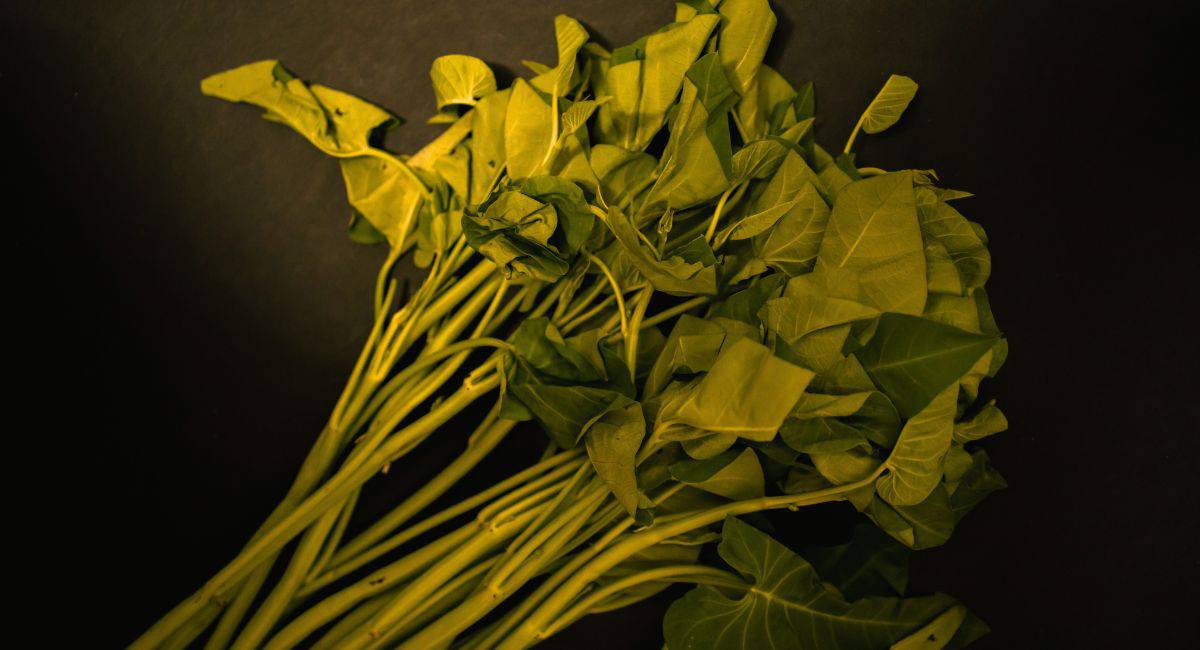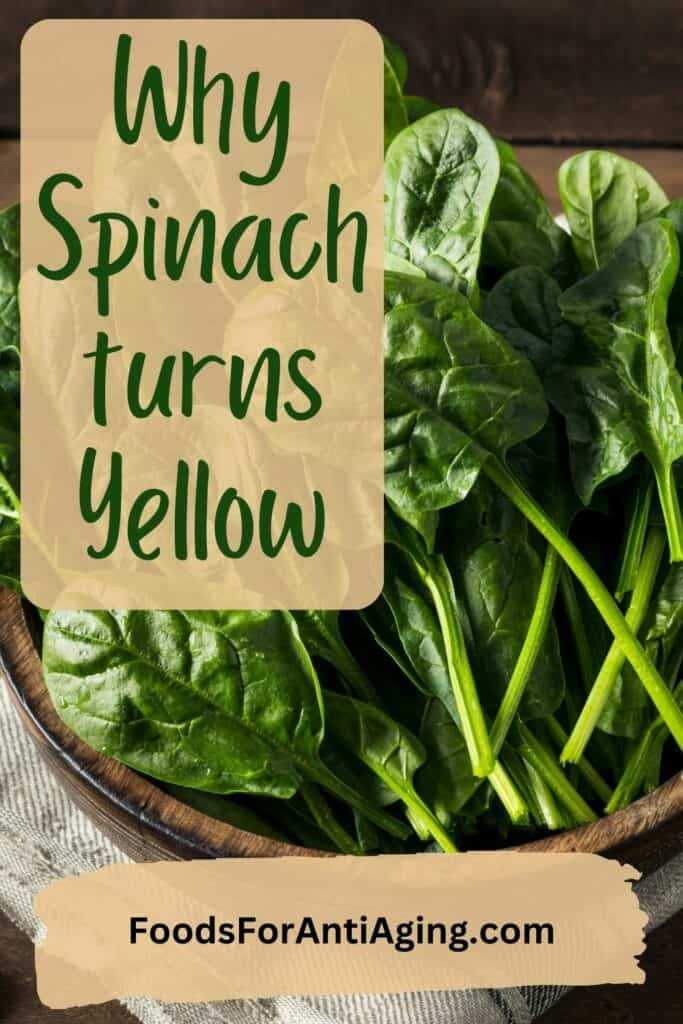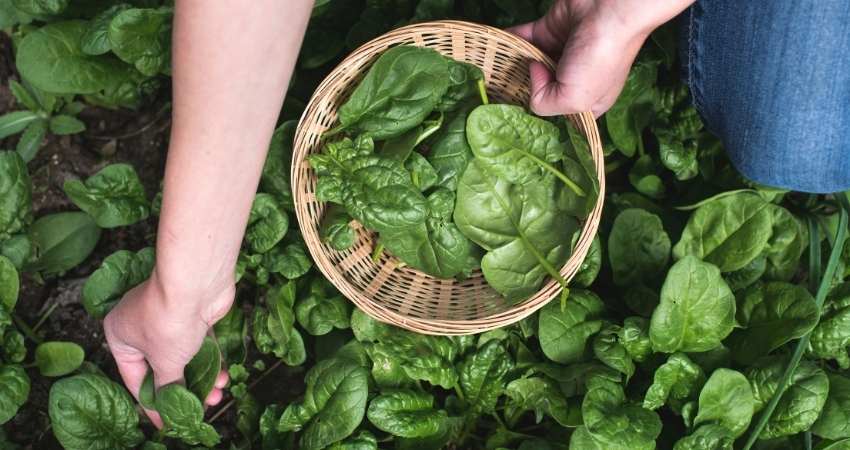Why Spinach Turns Yellow: Spoilage, Deficiencies and Stress
It’s not uncommon for people storing spinach or gardeners to encounter an issue where the spinach green leaves begin to turn yellow. This signals a problem that can affect the plant’s growth and the quality of its produce.
Yellowing, known scientifically as chlorosis, can be caused by a variety of factors, each requiring its own method of diagnosis and intervention.
The two main reasons are spinach turning bad in storage and nutrient deficiencies.
This article will examine all the reasons why spinach may turn yellow and how to correct the situation in the future.
Spinach Turning Yellow When Bad

When spinach goes bad, one may observe several changes in its appearance. The leaves can start turning yellow, a sign that the spinach is past its prime and deteriorating in quality.
Discoloration is typically a response to the degradation of chlorophyll, the pigment that makes plants green. As spinach ages it loses this pigment and yellow hues become visible.
This process can be accelerated by improper storage conditions like excessive moisture or humidity, which may lead to additional spoilage issues.
Key Signs of Spoilage:
- Yellowing: Indicate the loss of chlorophyll as the plant ages or decomposes.
- Slimy texture: Often accompany discoloration, suggesting bacterial or fungal growth.
- Off odor: A sign that spinach is no longer fresh and should be discarded.
Proper Storage Tips:
- Keep dry: Ensure leaves are free from extra moisture before storage.
- Refrigerate: Store in a cold environment, ideally in a crisp drawer.
- Airtight container: A container or sealed bag can protect spinach from excess moisture and other contaminants.
One should remember that yellowing is not the only indicator of bad spinach; one should also look for other signs of spoilage, like an unpleasant smell or a slimy texture.
To extend the shelf life of spinach, proper storage is key. It should be kept in a moisture-free environment and used within the recommended time frame to avoid decay.
For more detail, check out my article, How to Store Spinach in the Fridge for Maximum Freshness.

Understanding Spinach
Spinach is a verdant and nutrient-rich vegetable that is as versatile in the kitchen as it is in the garden. It thrives under proper care and can be a rewarding crop for gardeners.
Botanical Profile
Spinacia oleracea, commonly known as spinach, belongs to the Amaranthaceae family. This leafy green has been a staple in diets for centuries due to its rich content of vitamins and minerals. Spinach is categorized as an annual plant and is known for its quick growth rate.
Optimal Growing Conditions
For optimal development, spinach requires a well-draining soil that is rich in organic matter. The ideal soil pH should be between 6.5 and 7.0.
Spinach favors cooler weather and tends to bolt in high temperatures, with an optimal growth range between 50°F and 70°F (10°C and 21°C). Adequate sunlight, about 6 hours daily, and consistent moisture help in maintaining healthy growth.
Life Cycle of Spinach
Spinach exhibits a swift life cycle and matures in as little as 4 to 6 weeks. It begins as a seed and quickly germinates, given the right soil temperature, which is typically between 40°F and 75°F (4°C and 24°C).
The plant then enters a vegetative stage, where leaves expand and roots deepen. Eventually, if exposed to long daylight hours and higher temperatures, spinach will enter the bolting phase, where it produces flowers and seeds, completing its life cycle.

Fundamentals of Yellowing
When spinach leaves turn yellow, it can often be attributed to changes in chlorophyll levels, nutrient imbalances or environmental stressors. These factors can disrupt the plant’s physiology, leading to yellowing, also known as chlorosis.
Chlorophyll and Leaf Coloration
Chlorophyll is the pigment responsible for giving plants, including spinach, their green color. Chlorophyll is essential for photosynthesis, allowing plants to convert light into energy. A drop in chlorophyll levels often results in the yellowing of leaves.
Key Nutrients and Their Roles
Spinach requires a balanced supply of nutrients for optimal growth:
Macronutrients: Nitrogen, phosphorus, and potassium are vital for the development of foliage, root systems, and overall plant health.
- Nitrogen: Crucial for chlorophyll production and vigorous leaf growth.
- Phosphorus: Supports energy transfer and root development.
- Potassium: Regulate water and nutrient uptake and is necessary for photosynthesis.
Micronutrients: Elements like iron, magnesium, and boron play significant roles despite being needed in smaller quantities.
- Iron: Integral for chlorophyll synthesis.
- Magnesium: A core component of the chlorophyll molecule.
- Boron: Important for cell wall formation and nutrient uptake.
Deficiencies in any of these nutrients can manifest as yellowing of spinach leaves. For instance, lack of nitrogen often leads to pale or yellow foliage as it hampers the production of chlorophyll.
Environmental Factors Impacting Coloration
The health and coloration of spinach can also be affected by environmental factors. Key issues include:
- Over or under-watering, each leading to poor absorption of nutrients.
- Excessive heat or cold, which can disrupt the plant’s metabolic processes.
- Soil pH levels that are not optimal for nutrient uptake.
- Pests and diseases that damage the plant’s ability to maintain healthy foliage.
Such stressors can induce or exacerbate the yellowing of leaves, making it crucial to maintain favorable growing conditions.

Common Factors of Yellowing in Spinach
Spinach leaves turning yellow can typically be traced back to a few common issues related to nutrient deficiencies, water and soil balance. Understanding these factors is crucial for maintaining healthy spinach plants.
Nutrient Deficiency Symptoms
Nutrient deficiencies manifest in various ways on spinach leaves, with yellowing being a primary indicator. Specific deficiencies correspond to distinct symptoms:
- Nitrogen Deficiency: Essential for leaf growth and chlorophyll production, a lack of nitrogen results in pale yellow leaves.
- Iron Deficiency: Interveinal yellowing, where the space between the veins turns yellow while the veins remain green, indicates iron deficiency.
- Magnesium Deficiency: This often causes older leaves to yellow from the edges inward.
- Potassium Deficiency: Spinach with potassium deficiency may exhibit yellowing along the leaf margins.
- Calcium Deficiency: New leaves may distort or display irregular yellow spots.
- Manganese Deficiency: It can result in yellow spots or patches, mainly on younger leaves.
- Boron Deficiency: This deficiency leads to overall yellowing, starting with the younger leaves.
Water and Oxygen Balance Issues
The roots of spinach plants need an optimal balance of water and oxygen to thrive:
- Overwatering: It can suffocate roots, leading to yellow and wilted leaves due to decreased oxygen availability.
- Underwatering: Causes leaves to turn yellow as the plant fails to receive enough moisture to support all its tissues.
Proper watering encourages a healthy root and leaf development.
Soil Quality and Composition
Soil properties have a direct impact on the health of spinach plants:
- Soil pH: Spinach prefers a soil pH between 6.0 and 7.0. Incorrect soil pH can hinder nutrient absorption.
- Poor Drainage: Leads to waterlogged soil which can result in root rot and yellowing leaves.
- Well Draining Soil: It ensures excess water can escape, preventing many issues associated with overwatering.
- Soil Quality: Rich in organic matter supports a steady supply of nutrients and promotes strong root growth.
Regular soil testing can help in identifying and rectifying the imbalances in soil composition.
Pests and Diseases
Several pests and diseases can contribute to the yellowing of spinach leaves. Identifying these problems early can help in effective management and restoration of plant health.
Identifying Common Pests
- Aphids: These small, sap-sucking insects cluster on the undersides of spinach leaves, causing discoloration and distortion.
- Armyworms: Larval stages chew on leaves, leading to significant foliage damage.
- Spider Mites: These tiny pests cause yellow stippling on leaves as they feed.
- Whiteflies: They congregate on leaf undersides, feeding on plant juices and leaving behind a sticky residue that can develop sooty mold.
- Cutworms: Cutworms may cause severe damage to young seedlings by cutting stems at the base.
| Pests | Damage Signs | Commonly Affected Growth Stage |
|---|---|---|
| Aphids | Yellowing, curling of leaves | Seedling to mature plants |
| Armyworms | Holes in leaves | All stages |
| Spider Mites | Yellow speckles on leaf surface | Especially in dry, hot weather |
| Whiteflies | Yellow, wilting leaves | Young to mature plants |
| Cutworms | Seedlings cut at soil surface | Seedling stage |
Recognizing Spinach Specific Diseases
- Downy Mildew: Appears as yellow spots on leaf surfaces which may develop into fuzzy mould on the undersides.
- Fusarium Wilt: This fungal disease causes yellowing and wilting, often starting from the base of the plant.
- Spinach Blight: A viral disease that results in yellowing and stunted growth of spinach plants.
| Disease | Symptoms | Causal Agent |
|---|---|---|
| Downy Mildew | Yellow spots, fuzzy under growth | Fungus |
| Fusarium Wilt | Yellowing, wilting leaves | Soilborne fungus |
| Spinach Blight | Yellowing, stunted plant growth | Virus |
Prevention and Control
Pests: Maintain garden hygiene and introduce beneficial insects like ladybugs. Use organic insecticides like neem oil to control infestations.
Diseases:
- Cultural Control: Rotate crops and incorporate organic matter to improve soil health and drainage.
- Chemical Control: Apply fungicides in accordance with local guidelines and only as a last resort if cultural control has failed.
Controlling pests and diseases in spinach involves an integrated approach that combines preventative measures with timely interventions. Regular monitoring and rapid response are key to healthy spinach plants.
Cultural Practices
Proper cultural practices are crucial for maintaining the health of spinach plants and preventing yellowing of leaves. These practices include specific irrigation techniques, soil management, and strategic crop management.
Irrigation and Watering Techniques
Spinach plants require consistent moisture levels in the soil to thrive. Regular watering ensures that the soil is sufficiently moist but not saturated. Overwatering can lead to root rot and a lack of oxygen in the soil, while underwatering can stress the plants, both resulting in yellow leaves.
- Watering Schedule: Establish a consistent watering schedule that maintains even soil moisture.
- Proper Watering: Apply water directly to the base of the plants to reduce leaf moisture and prevent fungal diseases.
Soil Amendment and Fertilization
A balance of nutrients is essential for the healthy growth of spinach. Soil testing can guide gardeners in amending the soil with the right amount of fertilizer and organic matter like compost or mulch. Overfertilization can be as detrimental as a nutrient deficiency, contributing to poor plant health and yellow leaves.
- Fertilization: Use a balanced fertilizer as indicated by soil test results.
- Compost and Mulch: Add compost to enrich the soil and mulch to conserve moisture and regulate soil temperature.
Crop Management Strategies
Effective crop management practices, including crop rotation and timely harvesting, play a vital role in preventing diseases and maintaining plant vigor.
- Crop Rotation: Rotate spinach crops to prevent soil-borne diseases and nutrient depletion.
- Harvesting: Harvest leaves regularly to promote growth and prevent overcrowding, which can contribute to disease and yellowing.
- Mulching: Apply mulch to maintain consistent soil moisture and temperature, and to reduce weed competition.
Seasonal and Climatic Influences
When considering the health of spinach plants, it’s important to understand the role that temperature, weather patterns, and seasonal variations play in their development.
Temperature and Weather Patterns
Spinach plants are sensitive to extreme temperature fluctuations, which can directly impact their growth and leaf coloration. Optimal growing temperatures for spinach range between 50°F and 77°F (10°C to 25°C).
High temperatures, especially when combined with intense sunlight, can accelerate the yellowing process, known as bolting, where the plant’s metabolism shifts towards seeding and flowering.
- Cold Stress: Exposure to cold snaps below 20°F (-6°C) can damage plant tissues, causing leaves to yellow and wilt.
- Heat Stress: Prolonged exposure to temperatures above 77°F can lead to leaf yellowing as the plant struggles to maintain essential processes.
Effects of Seasonal Changes
Seasonal transitions, particularly the shift from spring to summer or summer to fall, create dynamic environmental conditions that can influence the health of spinach plants.
Spring: During spring, the lengthening daylight hours and moderate temperatures support healthy leaf production. However, late frost can cause yellowing.
Fall: The cooling temperatures of fall are generally favorable, but reduced daylight hours limit photosynthesis, which can lead to yellowing leaves if not managed properly.
It’s vital for gardeners to monitor their local weather and seasonal forecasts to anticipate and mitigate adverse effects on their spinach crops.
Addressing Yellowing Leaves
When spinach leaves turn yellow, gardeners need to diagnose the problem accurately, implement corrective measures, and ensure ongoing care for plant health.
Diagnostic Approaches
Identifying the cause of yellowing in spinach leaves is the first step in addressing the issue. Gardeners should look for:
- Nutrient Deficiencies: Yellowing often begins at the tips and moves down the leaf, indicating possible phosphorus or nitrogen shortages.
- Watering Issues: Both under-watering and over-watering can lead to yellow leaves, the latter potentially causing root rot.
- Pest Infestations: Pests like aphids and spider mites can cause stress and discoloration.
- Disease Presence: Diseases like blight may manifest as yellow spots.
- Environmental Stressors: Excessive heat or poor air circulation can also be detrimental.
Corrective Measures
Once the cause is pinpointed, the gardener can take action:
- Fertilization: Apply fertilizers rich in the deficient nutrient, being either phosphorus or nitrogen.
- Water Management: Establish a consistent watering schedule that avoids extremes.
- Pest Control: Introduce beneficial insects or use organic pesticides.
- Disease Management: Remove affected leaves and improve plant spacing for better air circulation.
- Environment Adjustment: Provide shade during intense heat and ensure the soil is well-draining.
Monitoring and Ongoing Care
Continuous observation and care are essential to prevent recurrence:
- Regularly check for signs of stress in the leaves.
- Monitor soil moisture and adjust watering as needed.
- Watch for signs of bolting, such as rapid vertical growth and flowering, which can lead to yellow leaves and a bitter taste.
- Ensure adequate air circulation to discourage disease.
- If yellowing persists, evaluate and adjust care practices accordingly.
If you have any questions to ask me about this article don’t hesitate to comment below or email us. You can find an email on our contact page.
Read More Spinach Storage Articles
How Long Does Spinach Dip Last?
How to Store Spinach in the Fridge for Maximum Freshness
Article Resources
- PennState: Your Produce May Be Getting Gassed In The Refrigerator
- University of San Diego: Ethylene in Fruits and Vegetables
- FDA: Are You Storing Food Safely?
